Classical styles:
Antique interior is arches, columns, sculptures, art painting. Integrity, symmetry and perfection. The color scheme - blue, green, terracotta shades, gold, black and ivory. Materials - stone, wood, ivory, clay, marble. Floors - mosaic. Painted, embossed ceiling. Furnishings are low, simple massive forms. The legs of interior items can be in the form of animal feet or figures of griffins. Carpets with a long pile. Nobility in every detail.
Example of interior:
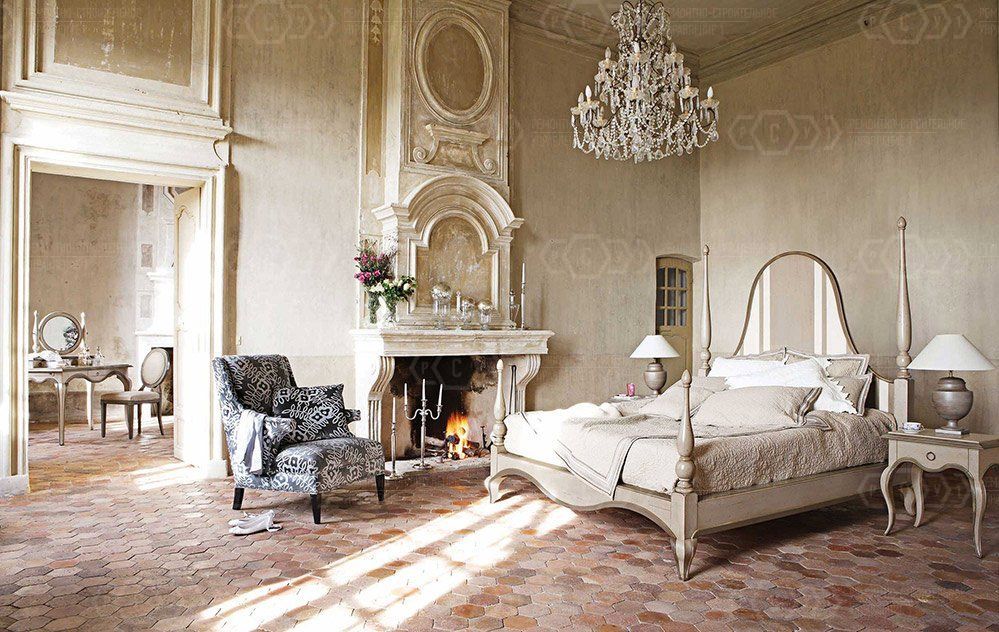
Victorian interior is, above all, conservative, austere and elegant. Wrought iron fittings, carvings, large fireplace, wide staircase, heavy doors and huge windows. Materials - wood, leather, velvet, satin. Wall covering - wooden panels or dense wallpaper (stripes, vegetable ornament). Floor covering - parquet made of natural wood. Color scheme: brown, beige and bordeaux. Carpets with a fine pattern, exquisite curtains, decorative pillows and plaids, candlesticks, fabric lampshades, paintings, wall clocks, cabinet and library - all these are the hallmarks of the Victorian style. Richness and, at the same time, a sense of proportion.
Interior example:
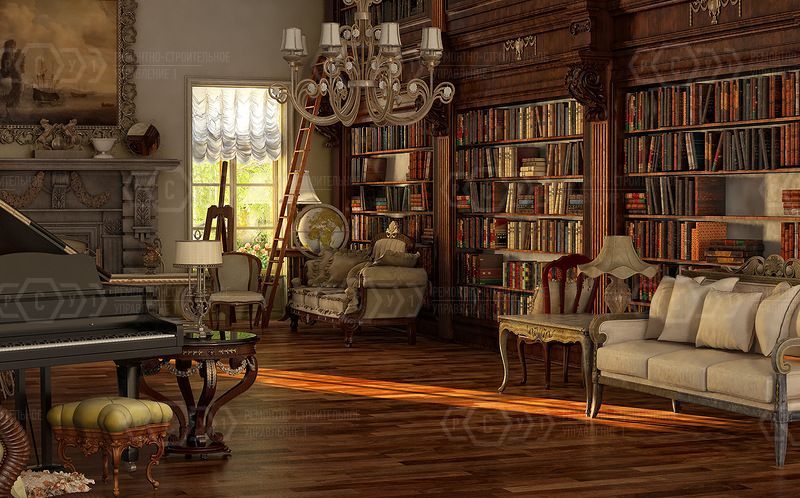
Electicismin interior design is the mixing of several styles united by color or texture. The use of wall moldings, multi-level ceilings. All the furnishings of a given style gives the impression of decorative (openwork chair backs, patterns in the form of scrolls) and contains unusual elements. In the interior there are exotic indoor plants, gilded decorative frames and the presence of many small items that connect the styles.
Interior example:
.jpg)
Aristocratic and refined Rocococo – is an aesthetic delight, cozy and festive every day. Rococo is characterized by a lot of details, accessories, elements of decorative load. Stucco, frescoes, tapestries, relief carved panels, rocaille and cupids, flower garlands, ornaments of fruits and leaves - all this can be found in the interior of a given style. Windows and doors – rounded shape, with silk curtains. On the floor is a parquet board or ceramic tiles. Furniture – miniature, carved, wavy shapes. The screens, dressing tables, dressers, armchairs, sofas, benches, embroidered cushions and porcelain vases are light and elegant. The color scheme is soft and gentle – pearl, pearlescent, beige, bluish shades. Rococo – very warm and comfortable, well suited for the design of any living space.
Example of interior:
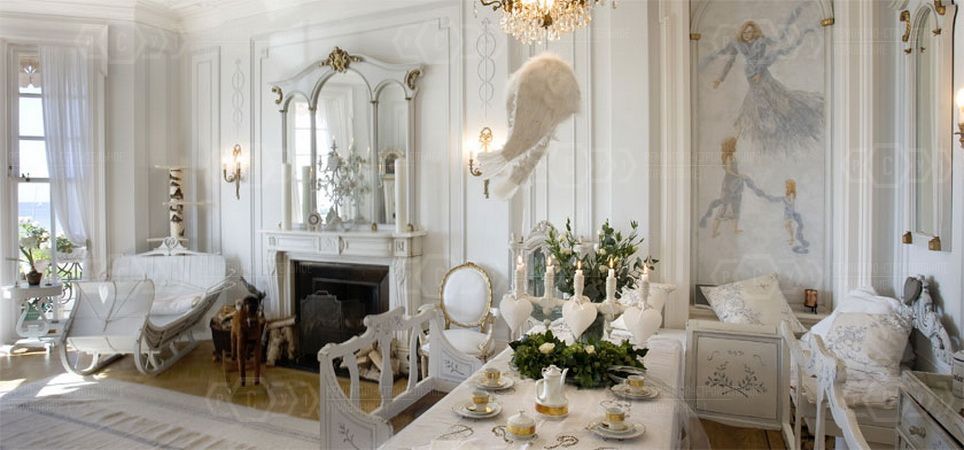
Goodness and self-sufficiency combine in one of the most expensive classic styles – Ampire. Logical, balanced and cool. Wood, gilded bronze, natural stones – this is Empire. Furnishings – rectangular, massive, polished, decorated with reliefs of expensive wood (mostly red), canopies. Elements of decoration – antique and Egyptian attributes of grandeur (weapons, masks, banners, helmets, armor, sphinxes, mummies, large mirrors). The color scheme is rougher and more contrasting than other classic styles (blue, green, yellow, crimson). Empire is well suited for the design of official premises (offices, conference rooms), where strictness, weightedness and steadfastness are always appropriate.
Example of interior:
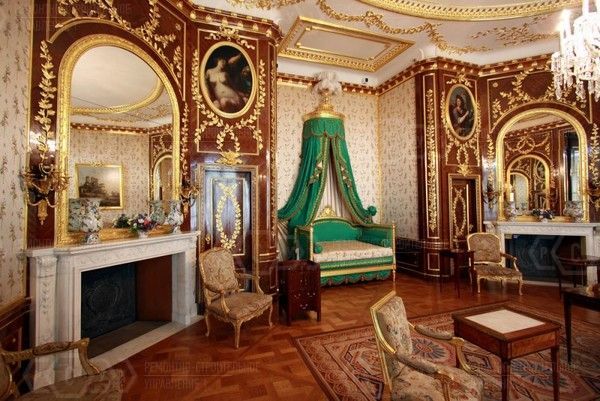
Gothic in interior design is huge windows without curtains, stained glass windows, complex shapes of vaults, openwork ornaments, verticality of all elements and, of course, mysticism in every square meter .Materials - stone, wood, marble, tile mosaics, metal hardware. Stained glass windows create a special atmosphere with light effects. A bright element of the Gothic style is the rose window. Furniture on high legs: wooden cabinets, cupboards, chests, tables with folding table tops, large beds with canopies or wooden frame.
Interior example:

The best choice, in interior design, for lovers of opulence and pomp – is, of course, Baroque. Characterized by excess and luxury. The central elements of the decor – are magnificent carpets and huge mirrors, decorated with gold, stucco, precious stones. Marble, mosaics, gold, silver, expensive exquisite fabrics – all this is baroque. Fittings - rounded, wavy shapes. Decorative upholstery, attached to nails with round large caps. Numerous paintings and sculptures. Baroque – it is atmospheric, fabulous and plastic, filled with theatricality and unpredictability.
Interior example:

Renaissance is aesthetic and airy. The style is characterized by rounded arches and windows, semicircular niches, frescoes and wall paintings, high vaulted ceilings with moldings, sculptures. Spacious rooms. Finishing materials – marble, wood of expensive species, natural stone. Location of furniture – along the walls, which gives even more monumental room. Furniture fittings with inlays and paintings (fabrics - velvet, leather, brocade). Pastel soft shades. Floor – tiles (stone or marble), with geometric ornamentation. Luxurious carpets. The interior in the chosen style is not overloaded with decor (mainly statuettes, vases, candlesticks and lamps). Renaissance will be an excellent choice for lovers of classics, harmony and freedom.
Interior example:
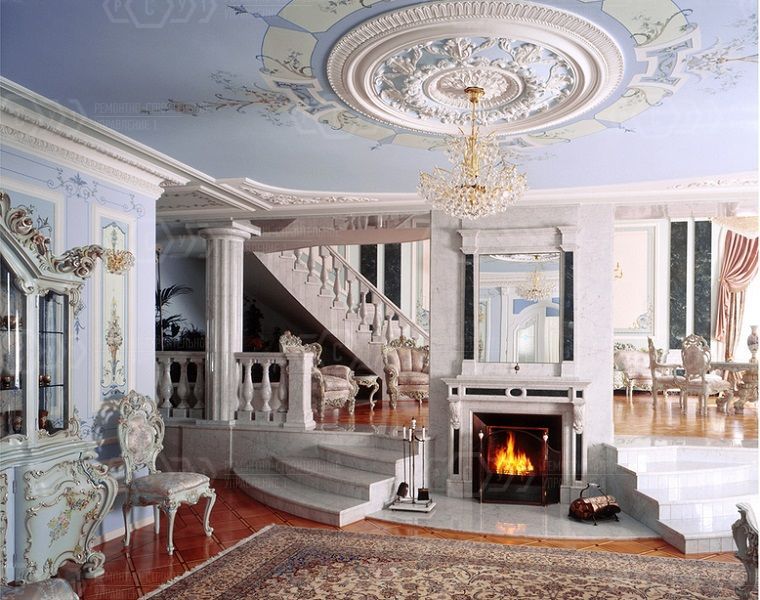
Classicism -rich and lush, yet balanced and restrained. Stucco, gilding, wall paintings, fireplaces, arches, columns, exquisite parquet – obligatory elements of classicism. Decor in the given style strictly observes symmetry. High ceilings, spacious rooms, with clear zoning. Furniture fittings of rounded forms (wood, stone, leather, embossed fabric). The use of antique attributes of decor. Luxurious chandeliers, paintings, mirrors. Shades are light, gentle, soft. In the details a lot of gold and silver. Refined and at the same time monumental, emphasizing the status of the owner of the interior.
Interior example:
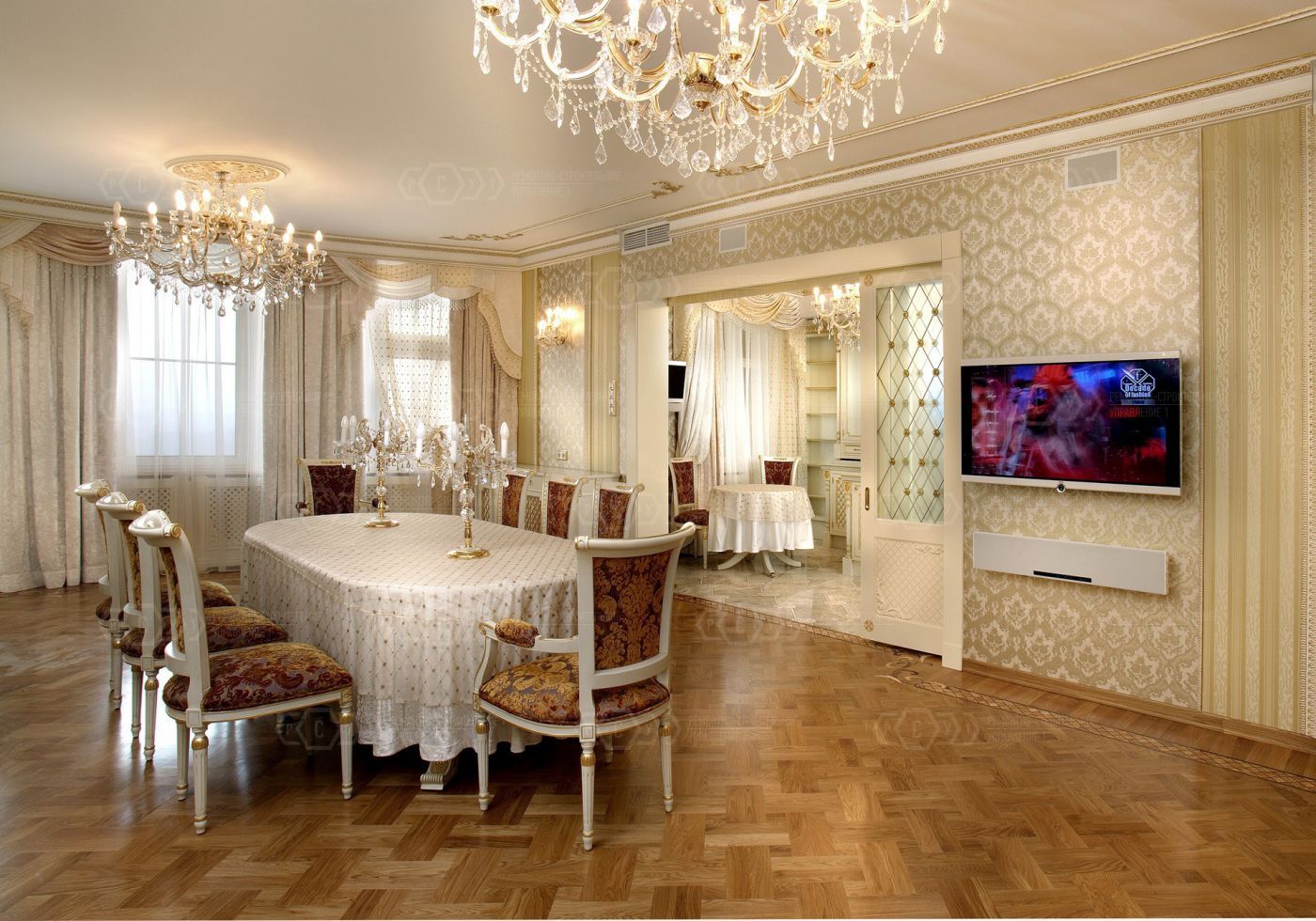
Modern is all about curved lines, abstract, flexible shapes and functionality. The decor is dominated by plant and animal ornaments. Art Nouveau harmoniously synthesizes elements of different styles. Materials - wood, stained glass, mosaics, porcelain, tiles, bronze, stone, expensive fabrics. Color scheme - natural shades: white, beige, mustard, olive, violet, blue, brown.
Example of interior:

Avant-garde — it's contrast, it's experimentation, the combination of the uncompatible. Bold choice of colors, change of familiar forms, unusualness. Furniture, bright and saturated colors (red, white, black), placed in the center of the room. Small elements of decoration are absent. Finishing materials - preferably modern: decorative plaster, metallized wallpaper, suspended ceilings, laminated coatings.
Example of interior:
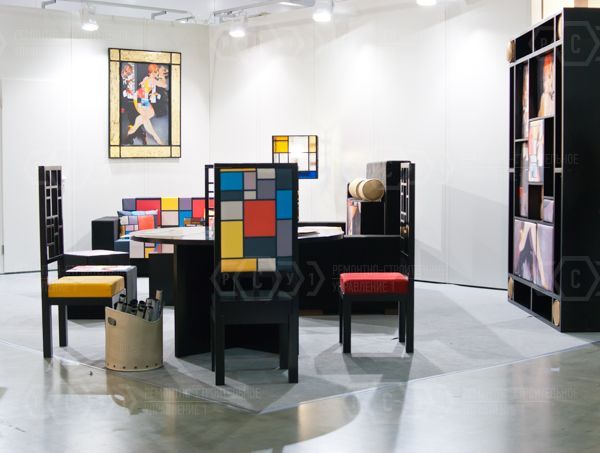
Modern styles:
Shebby is shabby chic. Shebby is new life to old things. Artificial aging of new (scuff effects) or the use of antique interior items. This style uses only gentle, pastel colors (light pink, white, beige, blue). Ornament - roses, angels. Materials - traditional, high-quality. Walls in the shebby style - roughly processed and unevenly painted walls, ceiling - artificially aged with the effect of peeling whitewash. Welcome elements of handmade decor and antique, vintage items.
Example of interior:
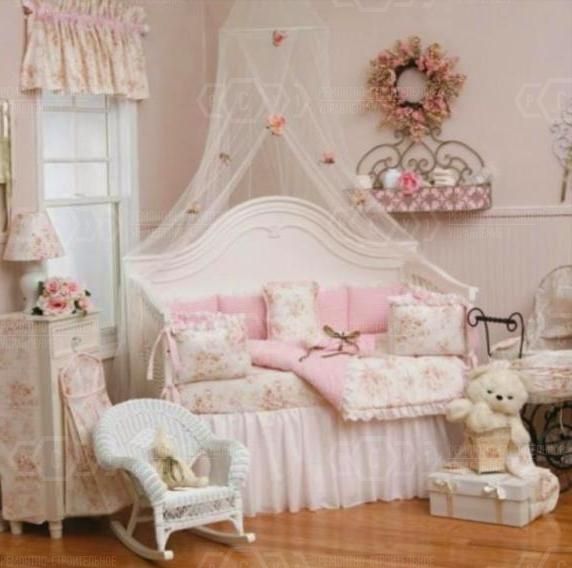
Interior solution - Bungalow well suited for decorating single-story small rooms with low ceilings. The ceiling and floor are natural wood. The arrangement of rooms around a common living room. Each zone of such an interior is maximally functionally involved. Furniture is preferably built-in. Maximum free space. Colors – brown green, scarlet, blue, orange. Airiness and brevity in everything.
Interior example:
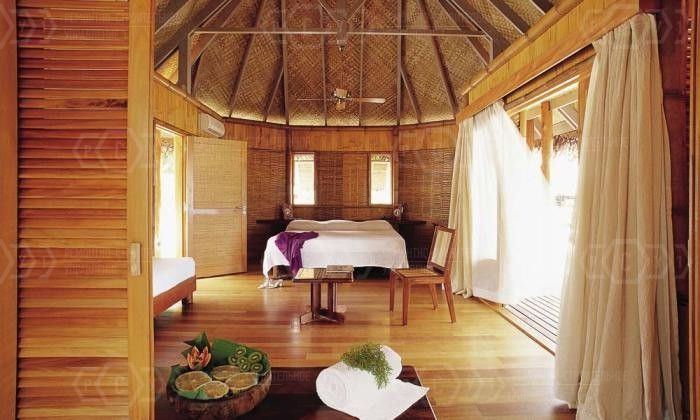
Country - warm, cozy. Evokes the feeling of being in a "rustic cabin". Floor - tile or wood. Palette - muted multicolor. Fittings are voluminous, wicker or wooden. Natural fabrics - calico, linen. Decor elements - knitted plaids, bedspreads, pillows, baskets, framed photos, vases with herbariums, clay figures, shelves, lace napkins. And, of course, the key element of the interior - the fireplace.
Example of interior:
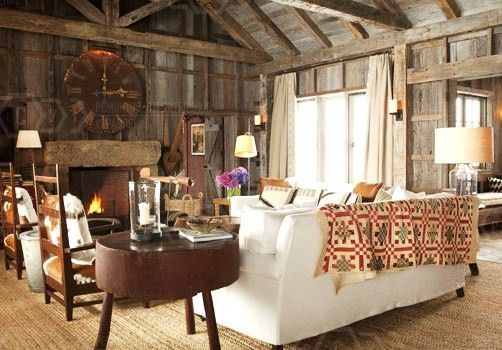
Kitsch is chaos and dissonance. Spectacular and epathetic. Imitation of several design trends at the same time. Screaming colors, an abundance of decorative elements, mixing a lot of accessories of different styles, the use of cheap jewelry and the lack of any canons or rules in the design.
Example of interior:
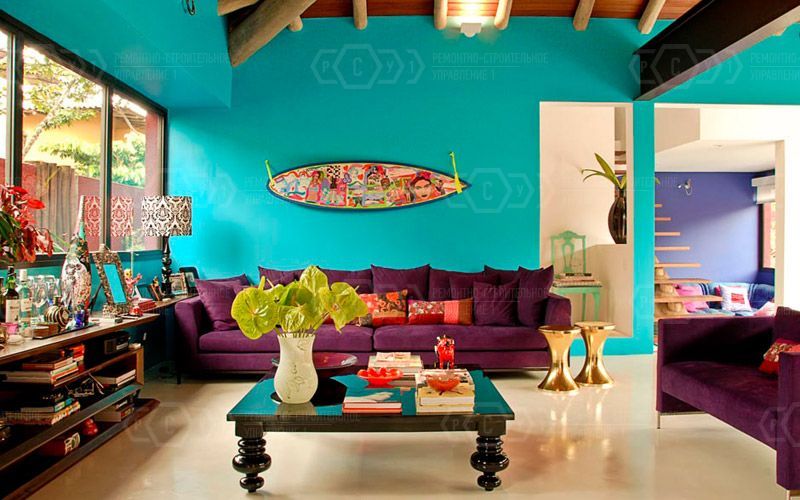
Minimalism is primarily about functionality and geometricity. The visual increase of space by color and light. Light-colored rooms, warm, pastel palette. Materials - glass, plastic, wood, metal, tile. Bright spots in the interior - upholstery furniture. Furniture is sharp, strict, without ornamentation and carving. Absence of non-functional elements of decor.
Example of interior:
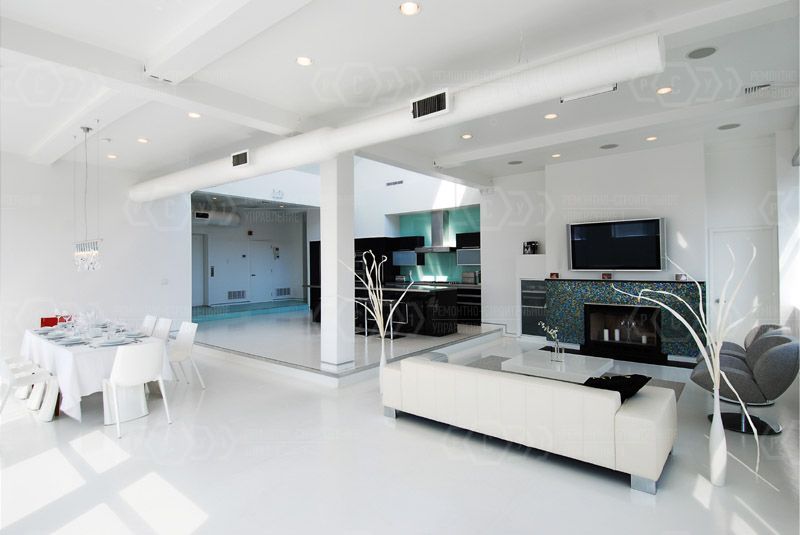
The striking and dynamic interior in Pop Art style gives a bright mood every day. Materials - plastic, plastic, synthetic, wood, tile. Different level, asymmetrical ceilings. Fittings shouting colors, more often glossy, futuristic and unusual shapes. Decor elements - multicolored lamps, posters, posters, posters, plush hearts, cheap souvenirs, advertising signs, portraits or photos of iconic personalities, logos of famous brands.
Interior example:
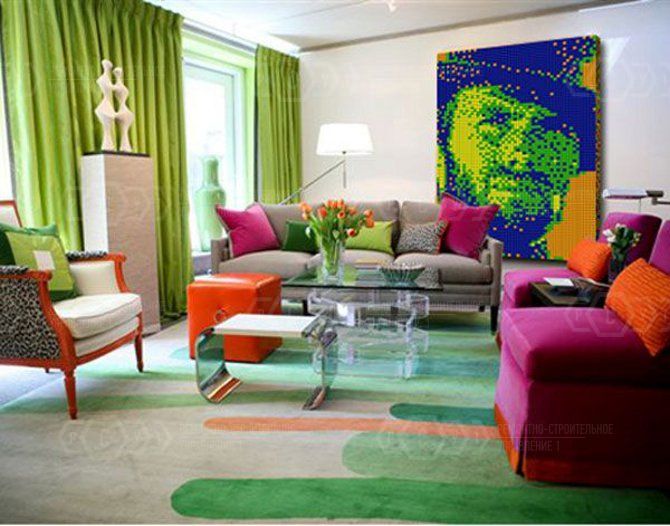
Postmodernism is chaotic, irrational, ultra-modern. Unexpected interior solutions, free layout, furniture "scattered" around the room. Palette - beige, silver, pearlescent colors. Materials - wood, chrome, artificial leather, metal. Ceilings - multilevel. Accents on doors and windows. Combination of interior items from different styles.
Example of interior:
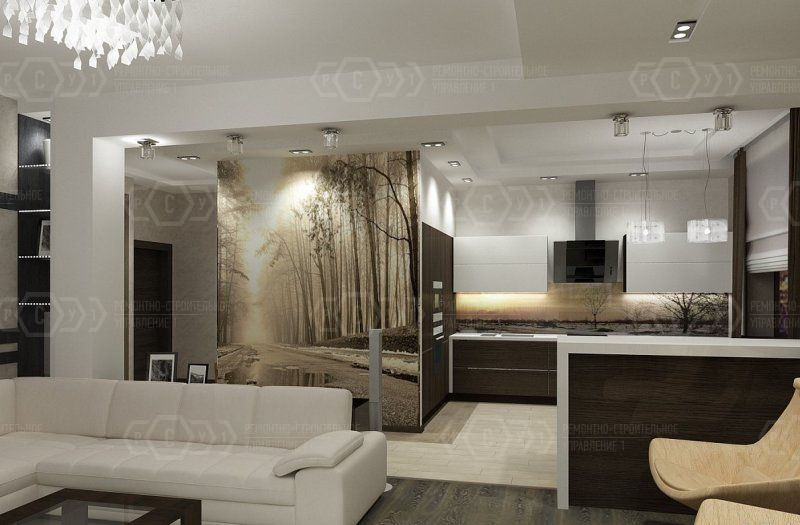
An extreme and unconventional choice for interior design is Techno. Materials - metal, stone, plastic, glass. Colors– cold (gray, white, black, khaki, metallic). Furniture is low, with deep seats, reminiscent of production equipment. Strict geometric lines, glossy and matte surfaces. Communications can be part of the decor.
Interior example:
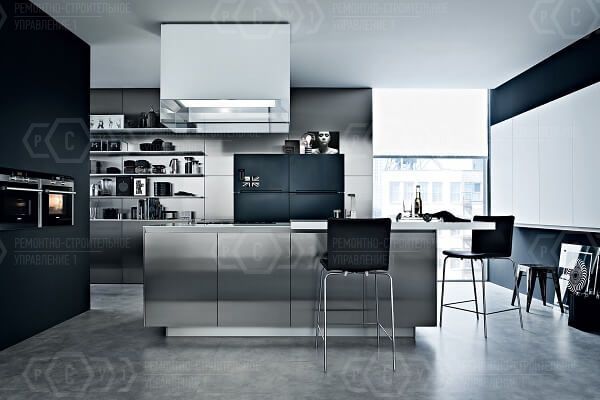
High-tech means maximum free space, modernity and restraint. Finishing materials - plastic, glass, metal. Presence of multifunctional constructions (partitions, sliding doors, multi-level ceilings). Walls without decorative finishing, painted in light gray, beige, black colors. The furniture is corporeal, the main attribute of the kitchen is a large bar counter. Soft furniture is monochrome. Carpets and curtains of the same color. Decor - wall photos or engravings in metal frames.
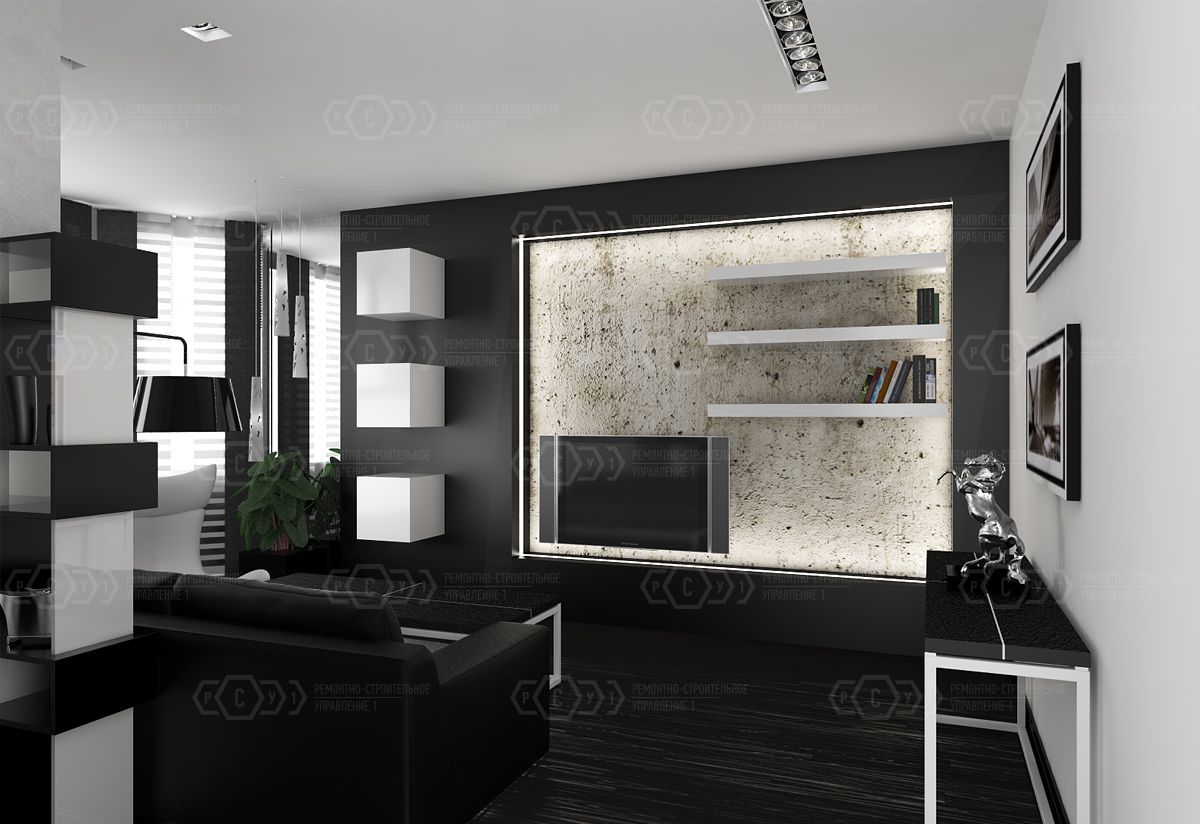
The philosophical, natural, natural interior design trend is Eco. The space decorated in the given style is light and airy. Materials are natural. The main material of finishing - wood (floor, ceilings, walls). Large windows, maximum daylight. Wicker and wooden furniture. Decor elements - hand -made, live plants, aquarium fish.
Example of interior:

Loft in interior design, lofts are huge rooms, with high ceilings and large windows. Industrial, modern, contrasting. Zoning by furniture. Only bedrooms and bathrooms are isolated. Materials - concrete, metal, wood, plastic. Walls - brickwork, metal panels or rough plaster. Bulky furnishings. Large sofas, armchairs, banquettes.
Interior example:
Ethnic styles:
Scandinavian interior - moderate and functional. Open floor plan. Large windows. No massive curtains, maximum daylight. The palette of design - light. Contrast and bright accents create upholstery upholstery upholstery furniture (monochrome bard, cherry, scarlet, dark). Practical furniture. Accessories - photos in frames, ceramic fish, sea shells.
Interior example:
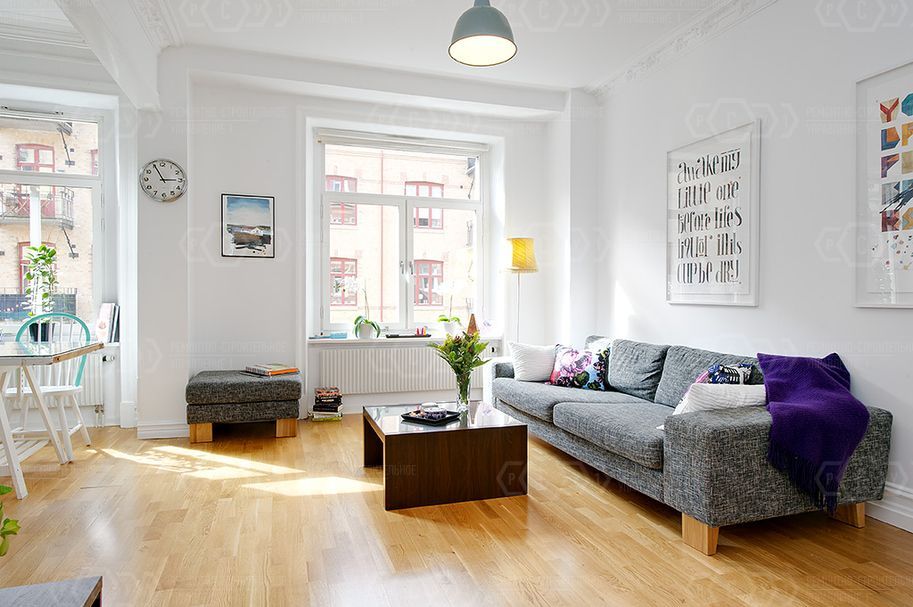
Chinese style - is exotic sophistication and peacefulness. It is a functional and harmonious interior. Zoning of the room - silk or bamboo screens. On the walls - bamboo wallpaper, wooden lattice or panels. The floor - tiles under the stone or wooden parquet. Palette – red, blue, yellow, gold, beige. The space is uncluttered. Polished, wooden furnishings. Decorated with hieroglyphics or plant ornaments. Mandatory presence of a group of furniture for the tea ceremony. Accessories – porcelain, vases, fans, scrolls, draperies with the image of dragons.
Interior example:
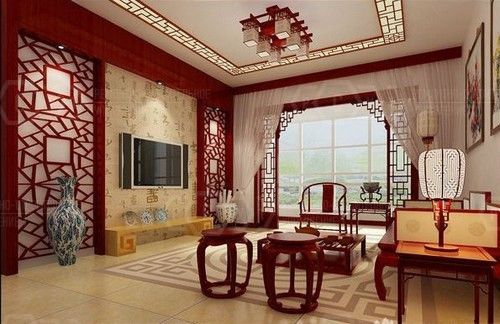
Japanese is strict minimalism. Shades of style – discreet autumn colors, the contrast of two or three rich warm colors, one of which – red. Zoning the room with screens, sliding harmonics. Materials - wood, bamboo, rice paper, metal. Furniture is few, low, functional. In the center of the room – group for tea ceremony. Decorative elements are few and laconic (dwarf plants, lamps and lampshades made of rice paper, vases).
Interior example:
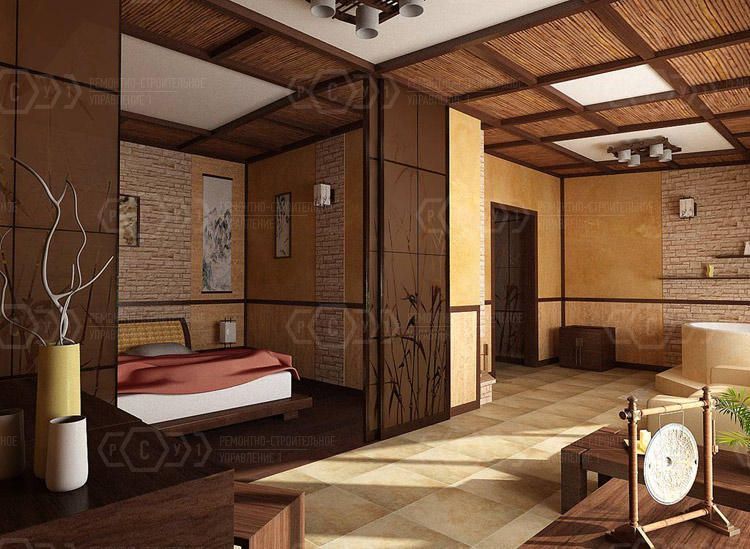
African interior - in interior design: colorful and edgy. Materials - wood, tile, bamboo, rattan, cane, leather. Palette - black, blue, chocolate, sand and fire colors. The white ceiling is decorated with wooden beams or bamboo. In the design there is a vegetal and geometric ornament. Decor - carpets, in the form of skins of wild animals, wooden statuettes, masks, fur plaids, pillows.
Interior example:
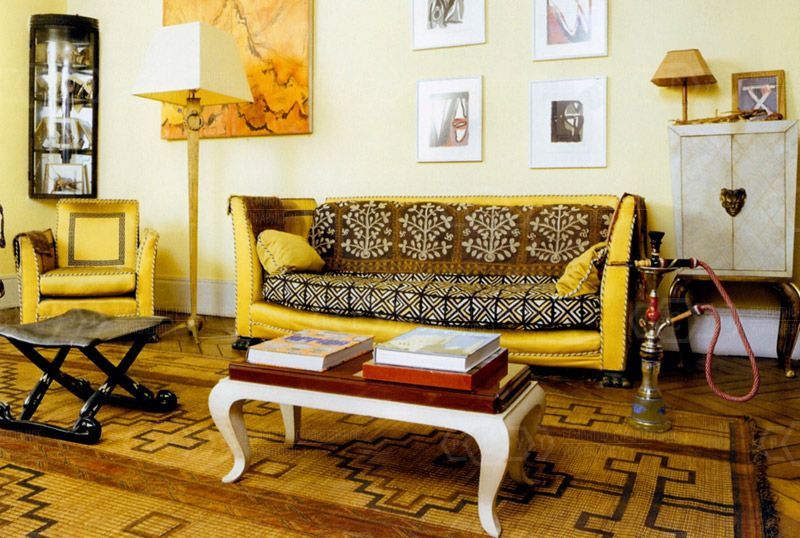
Eastern – is sophisticated and opulent at the same time. Maximum space and minimum furniture. Materials – wood, bamboo, reeds, tiles, marble, silk. Vaulted ceilings, arches. Walls are monochrome or draped with textiles. Shades are white, chocolate, beige, burgundy. Rounded, low furniture. Finishing of furniture with carvings and stones. Voluminous lamps. A large number of colorful carpets and pillows. Attention to detail.
Example of interior:

Symmetrical, luxurious interiors are Egyptian. It is characterized by expensive materials, columns, borders, sphinxes, busts, painted walls, marble and gilding. Colors: cream, yellow, sand, ivory, ochre, beige. In the decor use geometric ornament and Egyptian symbolism – solar disk, scarab beetle, papyrus, palm trees. The ceiling is painted or mosaic. Furniture is wooden, open and low. Pyramid silhouettes are used in decorative elements.
Example of interior:
.jpg)
Mediterranean style in the interior is laconic and distinctive. The walls are pastel colors. However, kitchen and soft furnishings can be bright. Silhouettes are straight and rounded. The presence of a large, wooden dining table is mandatory. The style is characterized by solid-colored, fluffy carpets, light, single-layer curtains. Elements of decor - forged or wicker baskets, moulages of fruits and vegetables, paintings.
Interior example:
.jpg)
English is pedantic, prim and cozy. The colors of the style are white, light pink and light salalate, beige, soft gray shades. Wallpaper is monochrome, striped or with heraldic symbols, plant ornaments. Windows - only wood. Flooring - parquet. Carpets are not flashy. Fittings are massive, wooden. Decor - engravings, pillows, vases, fabric lampshades, two-layer drapes to the floor.
Interior example:
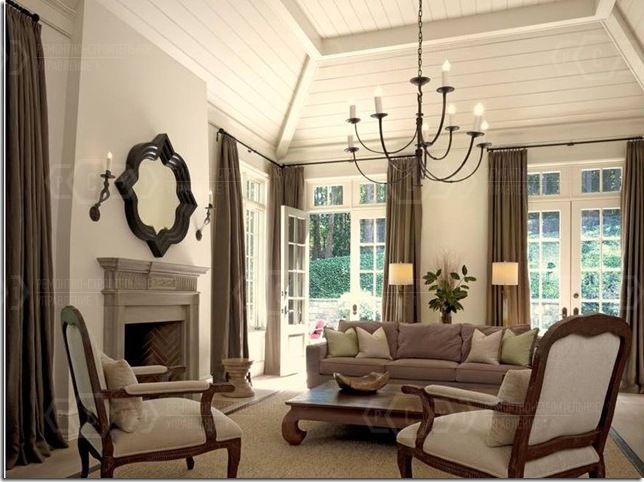
Provence is a provincial, gentle interior. Light shades dominate. Textured plaster. Wooden ceilings. Large, spacious windows. Materials - tiles, natural stone, wood. Fittings - wooden, wrought iron, wicker. Straight silhouettes. Decor elements - tablecloths, napkins, pillows, curtains, wicker vases, painted plates, fresh and dried flowers.
Interior example:
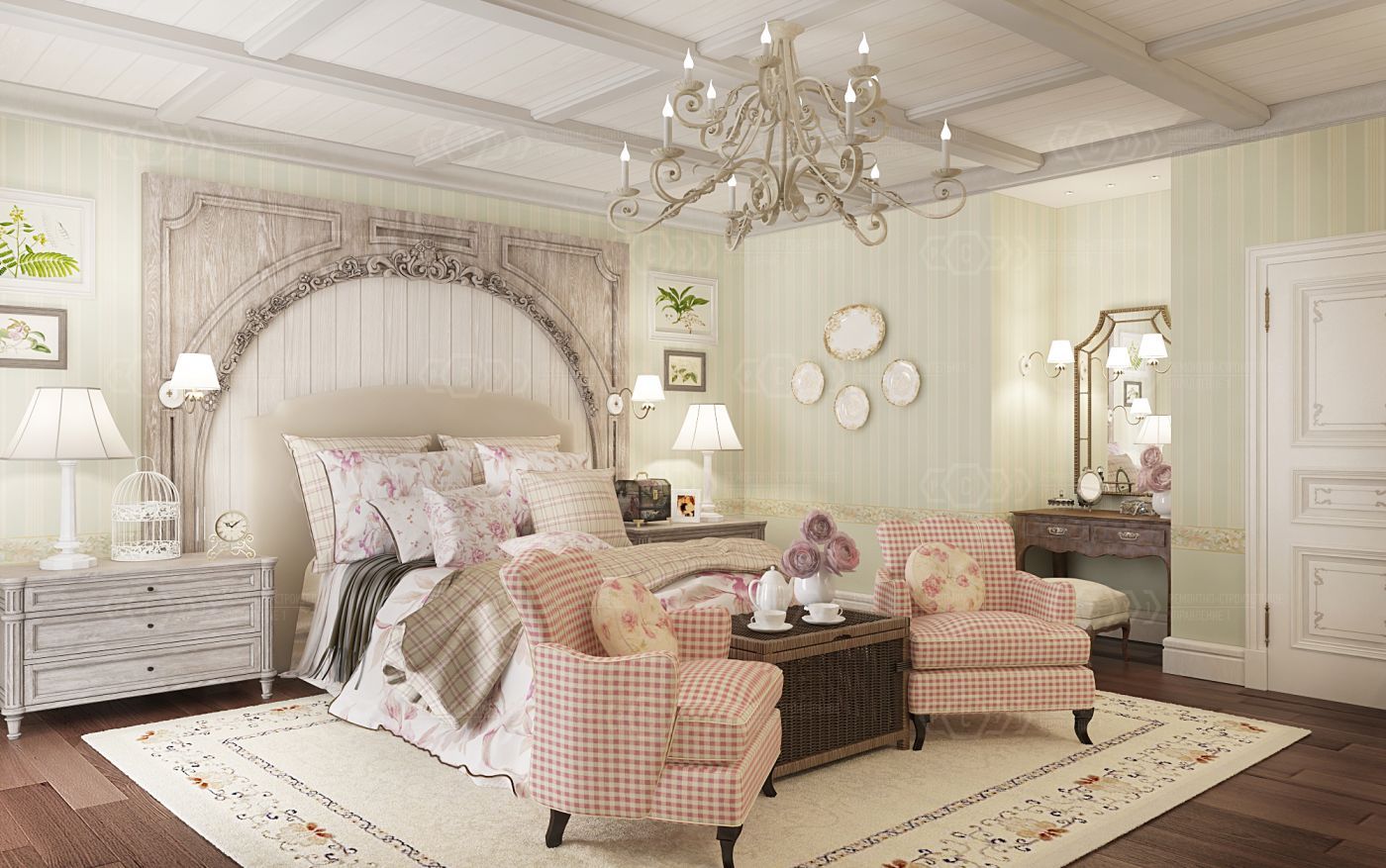
We do all types of remodeling work in all of the above styles. Check out our prices and examples of work there









